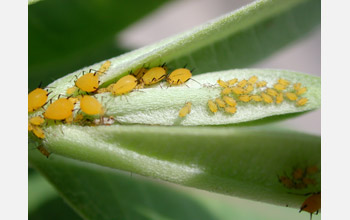Multimedia Gallery
Coexistence of Plant and Insect Species (Image 3)
Aphids (Aphis nerii) feeding on a milkweed plant (Asclepias syriaca). Herbivores like aphids circumvent the defenses in leaves by using straw-like mouthparts to access plant sap. Scientists are studying these organisms as part of their research on the community and evolutionary ecology of interactions between the milkweed plant and the insect herbivores that prey upon it. [Image 3 of 7 related images. See Image 4.]
More about this Image
Kailen Mooney, an assistant professor of ecology and evolutionary biology at the University of California, Irvine, and colleagues Rayko Halitschke, Andre Kessler and Anurag Agrawal of Cornell University examined 16 species of milkweed, a flowering plant found throughout the Western Hemisphere. Specifically, they wanted to determine the relationship among plant growth, the methods by which plants defend themselves against plant eaters (ex., thorns and toxins), and what type of protection plants receive from predator insects that eat the herbivore insects. Herbivores, such as aphids (which Mooney used in her study), damage plants, while predator insects, such as ladybugs, help the plants by eating the herbivores.
Mooney and her team wondered if plants were capable of thriving while having to defend themselves against herbivores and, at the same time, still attract protection from ladybugs and other predator species.
Milkweed species that grow quickly are more vulnerable to herbivore insects eating them because of poor defenses. This makes them more dependent on predator insects for survival. Basically, milkweed falls into one of two categories: hard-to-eat, slow-growing plants that don't need the help of predator insects; or prone-to-attack, fast-growing plants that rely on the help of predators.
"We can breed plants to grow rapidly but it appears that when we do, we're weakening the plants' immunity to herbivores, rendering them more needful of protection from potentially unreliable predators," says Mooney. "Milkweed has been evolving for as many as 20 million years. Natural selection favors faster-growing plants and those that easily fight off insects. If nature hasn't found a way to combine these traits, perhaps it's something that cannot be done."
The outcome of this research could be useful in agriculture, as researchers try and develop herbivore-proof, fast-maturing crops. To learn more about Mooney's research, visit the Mooney Lab website; or, visit Anurag Agrawal's lab at Cornell. [Research supported by a National Science Foundation CAREER (Faculty Early Career Development Program) award, DEB 04-47550.] (Date of Image: 2001-2010)
Credit: Anurag Agrawal, Cornell University
Images and other media in the National Science Foundation Multimedia Gallery are available for use in print and electronic material by NSF employees, members of the media, university staff, teachers and the general public. All media in the gallery are intended for personal, educational and nonprofit/non-commercial use only.
Images credited to the National Science Foundation, a federal agency, are in the public domain. The images were created by employees of the United States Government as part of their official duties or prepared by contractors as "works for hire" for NSF. You may freely use NSF-credited images and, at your discretion, credit NSF with a "Courtesy: National Science Foundation" notation.
Additional information about general usage can be found in Conditions.
Also Available:
Download the high-resolution JPG version of the image. (1.9 MB)
Use your mouse to right-click (Mac users may need to Ctrl-click) the link above and choose the option that will save the file or target to your computer.



